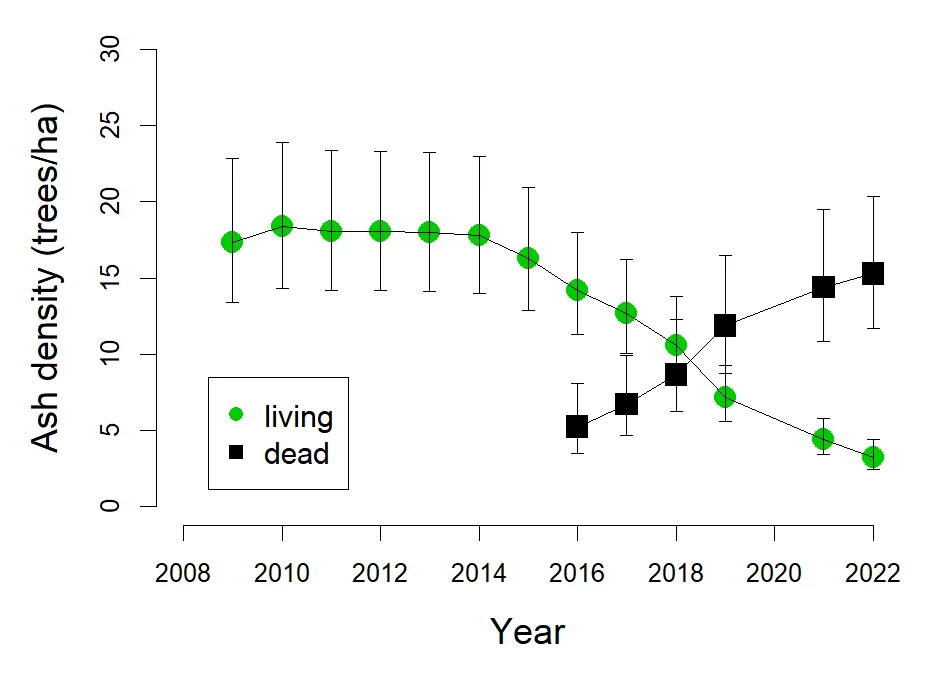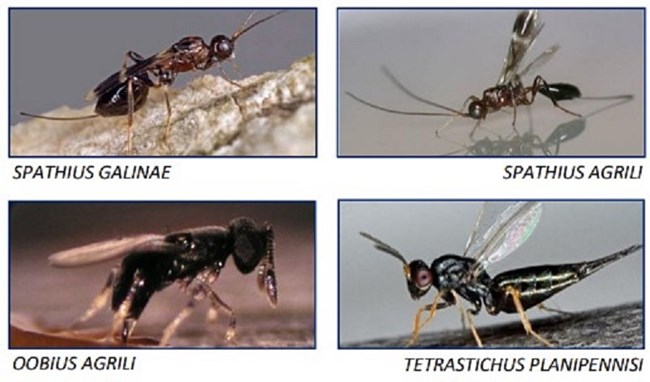Last updated: February 16, 2024
Article
Ash Tree Update 2022
By Nicholas Tait, NCRN I&M Science Communication Intern
Ash Trees Continue to Decline
Emerald ash borer (EAB), first detected in the National Capital Region in 2014, has killed the majority of the 300,000 ash trees once present in the region’s parks. The invasive beetle targets all ash tree species, laying eggs in cracks in their bark so larvae can feed on the woody tissue vital for transporting water and sugar within a tree. Nearly 100% of ash trees infested with EAB have been killed.
As of 2022, monitoring data from the National Capital Region Inventory and Monitoring Program (NCRN I&M) indicate that there are fewer than 56,000 surviving ash trees remaining in the region. The ashes that have died continue to swell the number of standing dead trees (snags), which may be nearing their peak (Figure 1). In the next few years, these snags will decline (both literally and numerically) as they fall to the forest floor.

NPS
But Seedlings and Saplings are Increasing
NCRN monitors ash trees of all sizes, from seedlings to saplings to adult trees. The number of individuals in each of these size classes has changed in recent years (Figure 2). While trees continue to plummet from the devastation of EAB, seedlings have seen a huge spike in density and sapling numbers are now starting to increase as well. The burst of seedling growth can likely be attributed to several factors including:
-
Ash trees naturally produce large quantities of small seeds that germinate quickly.
-
Stressed canopy trees producing an additional burst of seeds before they die.
-
Park deer management is increasing seedling survival.
-
Dying canopy trees allow more sunlight to reach the seedlings on the forest floor
The recent increase in sapling density, however, is likely a result of stump sprouting from many of the green and pumpkin ash trees in wetlands that have been hit hard by EAB but haven’t fully died. The stump sprouts have grown large enough to qualify as saplings (between 1 and 10 cm diameter at breast height) but not yet large enough to become appetizing to EAB. It is unclear, though, whether these now shrub-like ashes will continue to cycle indefinitely in that shrubby state or whether they will eventually form flowering and seed-producing trees.

NPS

USDA APHIS
What’s next for NCR’s ash trees?
It is still too early to know for sure. Based on trends in monitoring data since EAB invaded, I&M ecologists expect that ash trees will continue to decline for the next few years and large trees will likely be a rare occurrence in NCR parks. There are high numbers of ash seedlings, but it is unlikely that EAB will allow any of these seedlings to reach maturity. It is possible that our region’s ash in wetland areas could go the way of the American chestnut: seedlings grow into saplings or young trees that are large enough to be appetizing to EAB, they die, then the cycle repeats, with individuals rarely reaching canopy height or producing viable seeds.
The prognosis for ash trees could potentially improve with the continued spread of biological controls. The U.S. Department of Agriculture’s Animal and Plant Health Inspection Service (APHIS) has released several parasitoid wasps that hail from EAB’s native range in East Asia and serve as the beetle’s natural predators. As of 2020, APHIS had released over 8 million of these stingless wasps in 30 states and the District of Columbia. They’ve also recovered offspring in 22 states, including Maryland, DC, and Virginia, which means that the wasps are establishing themselves, reproducing, and killing EAB in the National Capital Region. The end goal of this release program is to have thriving wasp populations in every county with emerald ash borer infestations. Only time will tell if these biological controls have the desired impact on EAB populations and allow ash trees to rebound to their former standing in NCR forests.
Further Reading
Learn more about white ash trees in this NPS Species Spotlight on White Ash. Previous material on ash trees and emerald ash borer in national parks of the National Capital Region was published in online articles in 2021 and 2017.
Learn More about the National Park Service's Inventory & Monitoring Efforts
To help protect natural resources ranging from bird populations to forest health to water quality, National Park Service scientists perform ecological Inventory & Monitoring (I&M) work in parks across the country. The National Capital Region Network, Inventory & Monitoring program (NCRN I&M) serves national parks in the greater Washington, DC area. To learn more about NCRN I&M forest monitoring, you can visit the NCRN forest monitoring webpage.
Tags
- anacostia park
- antietam national battlefield
- baltimore-washington parkway
- catoctin mountain park
- chesapeake & ohio canal national historical park
- fort dupont park
- george washington memorial parkway
- great falls park
- harpers ferry national historical park
- kenilworth park & aquatic gardens
- manassas national battlefield park
- monocacy national battlefield
- national capital parks-east
- piscataway park
- prince william forest park
- rock creek park
- theodore roosevelt island
- wolf trap national park for the performing arts
- emerald ash borer
- ash
- fraxinus
- agrilus planipennis
- invasive non-native species
- insect
- invasive pests
- ncrn im
- ncrn
- i&m
- forest
- forest pests
- resilient forest management
- biological control
- wasp
- invasive species
- exotic species
- non-native species
